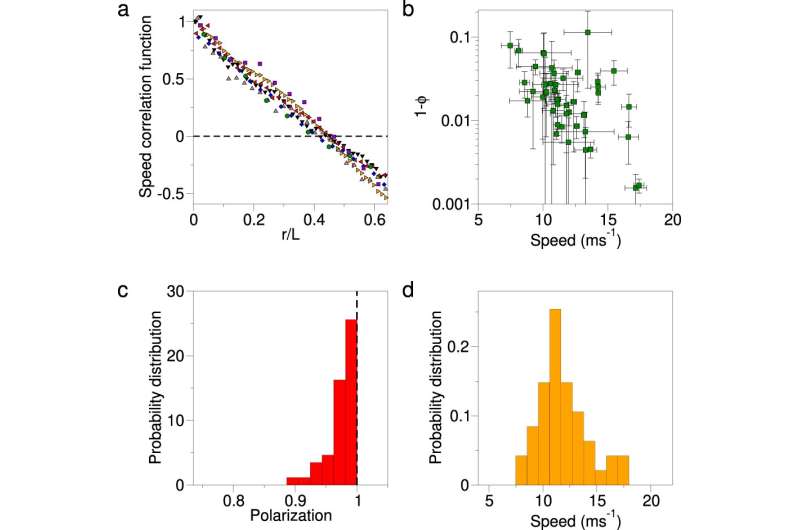May 11, 2022 report
Modeling how a bird's individual speed is regulated within a flock, such as during murmurations

Bob Yirka
news contributor

A team of researchers at Istituto Sistemi Complessi, Consiglio Nazionale delle Ricerche, UOS Sapienza and a colleague from IMT Institute for Advanced Studies has created a model that demonstrates how flocking birds regulate their speed. In their paper published in the journal Nature Communications, the group describes their mathematical model and its performance when compared against video of real birds.
Prior studies of bird flocking behavior, particularly during murmurations, has led to discoveries regarding flock integrity maintenance, even during rapid changes in direction. Studies to better understand individual bird behavior were based on linear models describing how each of the birds in a flock manage their flying speed. But these models cannot explain how flying birds in a flock can influence one another over long distances or account for speed variability within groups inside of a flock.
In this new effort, the researchers used a statistical field theory approach that ignores small deviations in speed and suppresses those that are large, resulting in a model that could take these variables into account. The researchers also accounted for individual bird size and for flocks of different size, ranging from 10 to 3,000 members. They ran simulations using their model to portray the action of flocks of birds in flight, and even during murmurations.
The researchers then analyzed the trajectories of individual birds in real starling flocks recorded on video and compared them to the actions taken by birds in their simulation and found them to be similar. They demonstrated that the model was able to reproduce correlations between birds represented in their model and those in the real world on a large scale. They acknowledge, however, that speed confinement may not be the only factor involved in maintaining flock integrity.
The group suggests their model adds a deeper understanding of group dynamics in general and could prove useful to roboticists attempting to get drones to carry out actions such as those seen in murmurations.
Written for you by our author —this article is the result of careful human work. We rely on readers like you to keep independent science journalism alive. If this reporting matters to you, please consider a (especially monthly). You'll get an ad-free account as a thank-you.
More information: Andrea Cavagna et al, Marginal speed confinement resolves the conflict between correlation and control in collective behaviour, Nature Communications (2022).
Journal information: Nature Communications
© 2022 Science X Network



















